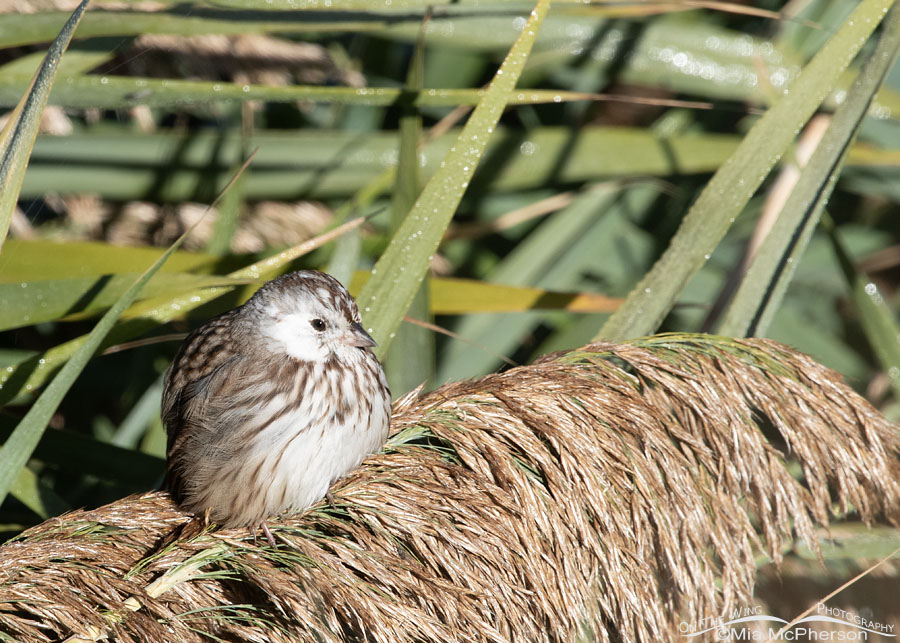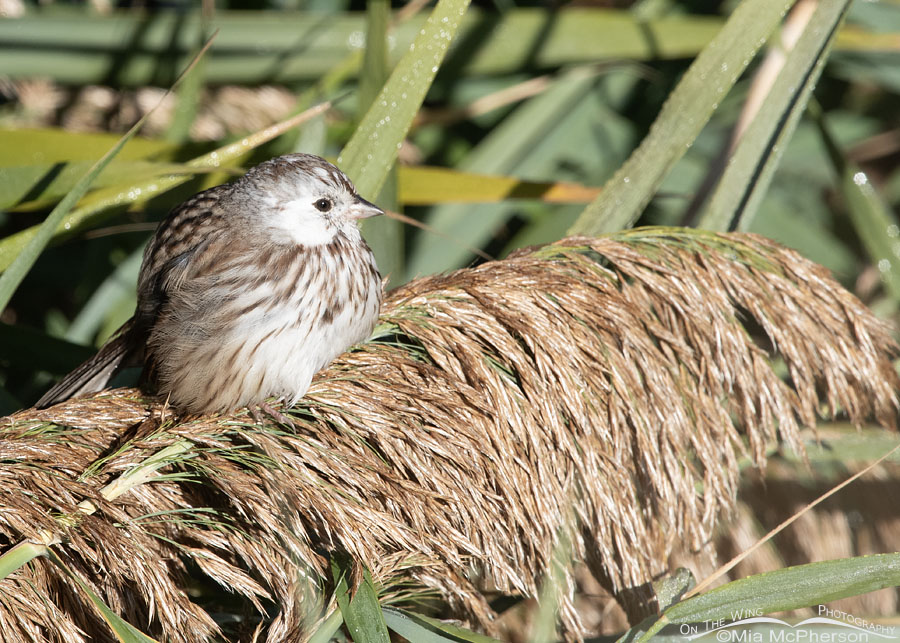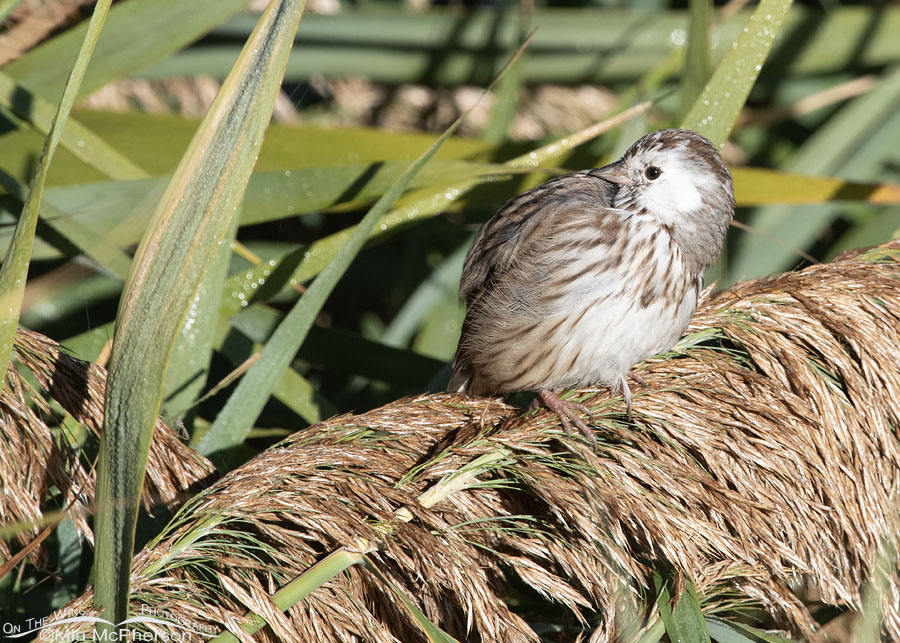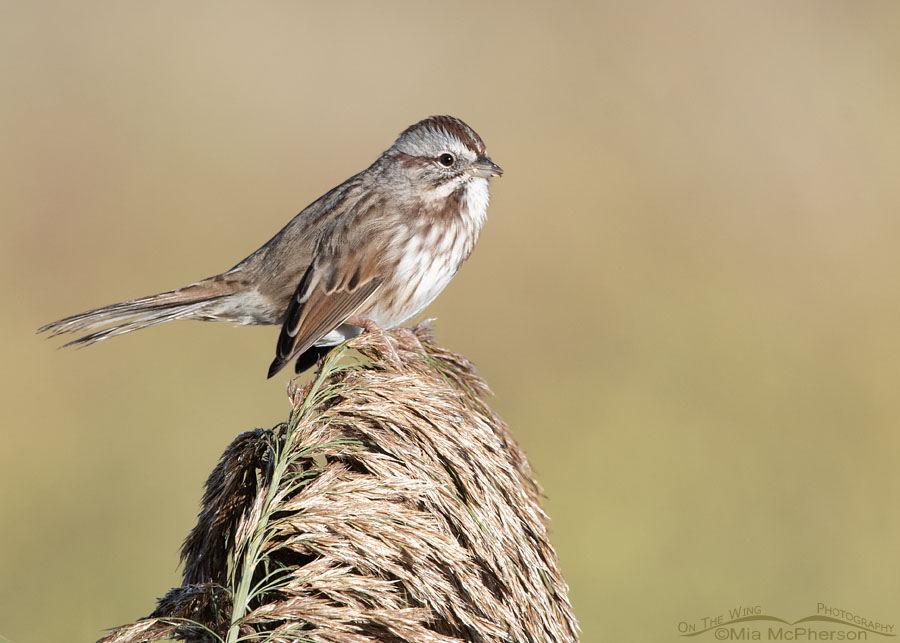My second gobsmack in a week occurred when I spotted a stunning leucistic Song Sparrow while driving slowly along the road at Farmington Bay WMA two days ago.
 Leucistic Song Sparrow at Farmington Bay WMA – Nikon D500, f8, 1/1250, ISO 640, Nikkor 500mm VR with 1.4x TC, natural light
Leucistic Song Sparrow at Farmington Bay WMA – Nikon D500, f8, 1/1250, ISO 640, Nikkor 500mm VR with 1.4x TC, natural light
I had been photographing a normal Song Sparrow, and when it lifted off, I slowly moved my Jeep forward until I saw this bird. It was resting on some phrags in the marsh, and its unusual white face glowed like a tiny beacon. That is what caught my eye first.
At that moment, I was focused on two things: taking photos of this unusual sparrow and identifying its species.
Because I don’t find leucistic birds all that often, I was buzzing with adrenaline and excitement. ‘Wired’ also might be a good word.
 Song Sparrow with leucism – Nikon D500, f8, 1/1250, ISO 640, Nikkor 500mm VR with 1.4x TC, natural light
Song Sparrow with leucism – Nikon D500, f8, 1/1250, ISO 640, Nikkor 500mm VR with 1.4x TC, natural light
I knew the bird was a sparrow from its general shape. My initial thought was that it was a Song Sparrow. I was about 95% sure of my identification, but that 5% of uncertainty niggled at me.
I shared a back of camera cell phone shot of the sparrow to my Facebook page, danced in my seat, and went looking for more birds to photograph after it flew off.
It is always thrilling to find a rare or leucistic bird.
 Perched leucistic Song Sparrow – Nikon D500, f8, 1/1600, ISO 640, Nikkor 500mm VR with 1.4x TC, natural light
Perched leucistic Song Sparrow – Nikon D500, f8, 1/1600, ISO 640, Nikkor 500mm VR with 1.4x TC, natural light
By the time I got home there were a few comments on my Facebook post and as I waited for my photos to upload I looked at them and the back of camera image I had posted. That is when I began to second guess my Song Sparrow identification. The streaking on the breast looked finer than I thought it should for that species.
I submitted the images to the American Birding Associations (ABA) “What’s This Bird?” group and waited to see if other people thought it was a Song Sparrow. The consensus was Song Sparrow.
It is perfectly okay for me to second-guess myself when it comes to tricky identifications; that is how I learn. Also, while I know a lot about birds, I don’t consider or call myself an expert.
Anyway, that is why I am sharing my second gobsmacked experience after my third one of the week.
I was second-guessing myself.
I’m simply delighted that I found and photographed this unusual and beautiful bird.
 Normal Song Sparrow in autumn – Nikon D500, f8, 1/1250, ISO 640, Nikkor 500mm VR with 1.4x TC, natural light
Normal Song Sparrow in autumn – Nikon D500, f8, 1/1250, ISO 640, Nikkor 500mm VR with 1.4x TC, natural light
In case you were wondering what a ‘normal’ Song Sparrow looks like, this is the one I photographed just before I found the leucistic sparrow.
Between the handsome Sharp-shinned Hawk, this wonderful, unusual sparrow, and the other birds I found and photographed, I had a fantastic day at Farmington Bay!
Life is good.
Mia
Click here to see posts on other leucistic birds that I have found and photographed. Click here to see more of my Song Sparrow photos plus facts and information about this species.
Definition of leucism:
an abnormal condition of reduced pigmentation affecting various animals (such as birds, mammals, and reptiles) that is marked by overall pale color or patches of reduced coloring and is caused by a genetic mutation which inhibits melanin and other pigments from being deposited in feathers, hair, or skin. The presence of unusual plumage contrasts (such as a very pale-winged bird with dark brown tail) is a strong indication of leucism. — David Allen Sibley


I love the different textures you captured in these shots. The subtle coloring of the sparrow is beautiful. Thanks Mia.
Wonderful. And equally wonderful to be gobsmacked in such positive ways.
Very fun find and I am glad your thoughts were confirmed.
Marvelous. You must live right!